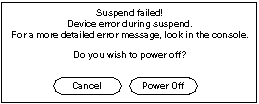Troubleshooting
This section describes the following:
-
What to do if power-on does not succeed
-
What to do if the power key does not suspend the system
-
How to recover from a hung system
-
What to do if suspend does not succeed
What To Do If Power-On Does Not Succeed
If you do not see the banner screen within 10 to 15 seconds after you turn on the power:
-
Check the power LED at the front of the system to see if it is lit.
-
Make sure the AC power cord is securely attached to both the power supply and the AC wall outlet.
-
Be sure the AC wall outlet has power.
-
Check to see that the keyboard cables are firmly connected.
-
Try pressing the power key again.
You should hear a beep as the machine comes on.
-
If the machine does not come on, try pressing the power switch on the rear panel.
See Figure 2-3.
Figure 2-3 Power Switch Location

If the power still does not come on, call your Sun sales office or a service provider.
If the Power Key Does Not Suspend the System
Use a shell window to check that the key processing daemon is present.
% ps -eaf | grep speckeysd
If the resulting output does not list /usr/openwin/bin/speckeysd, you should start it.
% /usr/openwin/bin/speckeysd
Recovering From a Hung System
If your system does not respond to the mouse or keyboard, perform the following steps:
-
If your system is on a network, wait a few minutes before taking any action.
A slow response may be due to network problems or delays. Check with your network administrator. If the response is not due to the network, go to the next step.
-
Press Stop-a.
Hold both keys down at the same time. Pressing Stop-a (or Break) puts the system into the monitor command mode (indicated by the ok prompt).
Note -If you use a Wyse WY-50, DEC VT100, or compatible terminal as the console with your SPARCstation Voyager system unit, press Break instead of Stop-a.
-
Type sync.
Your file system will be saved.
ok sync
-
When Stop-a (or Break) is not effective, turn the power off using the power switch on the back panel of the system.
See Figure 2-3. The system power will turn off without the Suspend sequence. When you turn the system on again, the boot sequence will begin. Your work will not be saved.
What To Do If Suspend Does Not Succeed
If Suspend does not succeed, an alert window will pop up and more information about the failure will be displayed in the console window.
Figure 2-4 Suspend Failed Example

If Suspend Does Not Succeed Do the Following
-
Select Cancel.
If you have not already saved your work, do so now.
-
Look in the Console window for more information.
You may be able to take corrective action.
-
Try Suspend again.
-
If Suspend succeeds, the system will save your activities and the system will power off.
-
If Suspend does not succeed, the alert will pop up again.
 Caution -
Caution - Save your work if you have not already done so.
-
-
Select Power Off.
Your work will not be saved. When you power on again, the system will reboot.
If Power Off Fails Do the Following
Figure 2-5 Power Off Failure Window

-
Select Continue.
-
Save your work if you haven't already done so.
-
Turn the power off after halting the system.
See "Changing the System Configuration" and Steps 2 through 4 of "Recovering From a Hung System".
- © 2010, Oracle Corporation and/or its affiliates
